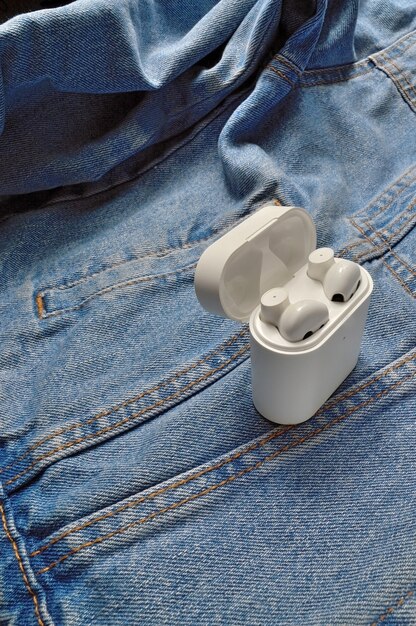Best Wireless Earbuds Under $100 for Battery Life in 2025

Finding the best wireless earbuds under $100 with exceptional battery life in 2025 involves balancing sound quality, comfort, and crucial playback duration given the rapid advancements in portable audio technology.
The quest for the perfect audio companion often leads us to a crossroads: premium features versus affordability. For many, the sweet spot lies within the under-$100 category, especially when the primary concern is battery longevity. In 2025, the market for wireless earbuds under $100: which ones offer the best battery life in 2025 is more competitive and innovative than ever, offering surprisingly robust options that defy their price tags.
The Evolving Landscape of Budget Wireless Earbuds
The audio technology sector is notoriously fast-paced, with innovation constantly pushing boundaries. This rapid evolution hasn’t bypassed the budget segment; in fact, it has democratized high-quality features, making them accessible to a wider audience. Gone are the days when affordable earbuds meant sacrificing essential functionalities like decent battery life or reliable connectivity. Today, manufacturers are employing clever engineering and efficient chipsets to pack impressive performance into devices that retail for less than a hundred dollars.
Understanding this evolving landscape is crucial for anyone looking to make an informed purchase. The sheer volume of options can be overwhelming, but by focusing on key indicators, consumers can navigate the market with confidence. The challenge isn’t just about finding cheap earbuds, but discovering truly capable ones that offer lasting power without breaking the bank. This segment has matured significantly, shifting from novelty items to genuinely practical daily drivers for millions.
Technological Advancements Driving Affordability
Several technological strides have contributed to the improved quality and battery efficiency of budget earbuds. These advancements are not isolated but rather interconnected, creating a synergy that benefits the end-user.
- Bluetooth 5.0 and Beyond: Newer Bluetooth versions significantly reduce power consumption while improving connection stability and range. This means your earbuds use less energy to maintain a strong signal.
- Efficient Chipsets: Manufacturers are now utilizing more power-efficient chipsets that process audio with less energy, extending playback time substantially. These integrated circuits are the brains of the operations, optimizing every mW of power.
- Improved Battery Technology: Advances in lithium-ion battery density allow for physically smaller batteries to hold more charge, leading to more compact earbuds with longer battery life.
These innovations collectively contribute to a more robust and reliable experience. It’s no longer a trade-off where affordability automatically means compromise. Instead, smart engineering and economies of scale are bringing once-premium features into the everyday price range, making long-lasting wireless audio a reality for the masses.
The fierce competition within the budget segment also plays a significant role. Every brand is striving to offer better value than its competitors, driving them to innovate on battery life, sound quality, and feature sets, all while maintaining an attractive price point. This competitive environment benefits consumers directly, ensuring that the market is always pushing towards better, more affordable solutions.
Key Metrics for Evaluating Earbud Battery Life
When assessing wireless earbuds, “battery life” isn’t a single, simple metric. It’s a multifaceted concept influenced by several factors. Understanding these nuances is essential for making an informed decision, especially when aiming for longevity under a specific budget. A common mistake is to only look at the total playback time on a single charge without considering the charging case or real-world usage scenarios.
The listed battery life by manufacturers is typically an ideal figure, achieved under very specific conditions, such as moderate volume and without active noise cancellation. Real-world performance can vary, which is why user reviews and independent tests are invaluable. Our focus here is to equip you with the knowledge to dissect these figures and understand what truly matters for sustained audio enjoyment.
Understanding Playback Time and Charging Case Contribution
The battery life of wireless earbuds is generally presented in two parts: the playback time on a single charge for the earbuds themselves and the additional charges provided by the charging case. Both are equally important.
- Earbuds on a Single Charge: This refers to how long the earbuds can play audio continuously before needing to be placed back into their charging case. For a truly long-lasting experience, aim for at least 6-8 hours, especially for under-$100 models.
- Total Battery Life with Charging Case: This is the cumulative playback time when combining the earbud’s single-charge life with the multiple charges stored in the case. A good total should be upwards of 24-30 hours, ensuring you can go days without needing a wall outlet.
- Fast Charging Capabilities: Some cases offer “fast charging,” where a quick 5-10 minute charge can provide an hour or more of playback. This feature is incredibly convenient for emergencies.
Beyond these primary metrics, other considerations like the size and portability of the charging case, and whether it supports wireless charging, can enhance the overall user experience. A bulky case, even with excellent battery, might negate its convenience for some users.
The total battery life offered by the charging case is often the deciding factor for those who travel frequently or simply don’t want to worry about daily recharging. A case that provides multiple full charges means greater freedom and less reliance on power outlets, a significant advantage for any portable audio device.
Contenders for Best Battery Life Under $100 in 2025

Identifying the top contenders for battery life in the under-$100 segment for 2025 requires a blend of current market analysis, manufacturer promises, and, crucially, user feedback and expert reviews. While an exhaustive list is impossible due to the rapid release cycle, certain brands and models consistently push the boundaries of what’s possible at this price point. Our focus is on models that not only rate highly in terms of raw playback hours but also maintain a respectable level of overall performance and reliability.
The competition in this budget tier is fierce, compelling manufacturers to continually innovate. This section delves into some of the standout options that have garnered attention for their impressive battery longevity, making them strong candidates for your consideration. We’re looking for compelling evidence of sustained power alongside a positive user experience, avoiding options that cut corners too drastically on other essential aspects like sound quality or comfort.
Leading Models and Their Battery Performance
Several brands have distinguished themselves in the budget wireless earbud market, consistently delivering products that punch above their weight, especially when it comes to battery life. These are often household names known for producing reliable electronics.
- Soundcore by Anker (e.g., Life P3i, A20i series): Anker’s audio arm, Soundcore, is a consistent leader in affordable audio. Their earbuds often boast 7-10 hours on a single charge and total playtime of 30+ hours with the case, frequently integrating fast charging.
- JBL (e.g., Wave Buds, Tune Buds): JBL offers a range of affordable options that balance decent sound with good battery life. Many provide 8 hours of earbud life and 32 hours total, with robust build quality suitable for active users.
- Edifier (e.g., W240TN, X2s): Edifier is known for its audio expertise, and its budget earbuds often excel in both sound quality and battery. Models frequently offer 6-8 hours per charge and over 25 hours total, with consistent performance.
These brands frequently update their lineups, so specific model names may evolve. However, their commitment to providing strong battery performance at an accessible price point remains a core tenet of their product strategy. Always check the latest iterations of their budget lines for the most up-to-date specs and user reviews, as performance metrics can sometimes vary slightly with new releases.
It’s worth noting that while raw battery hours are important, other factors such as the efficiency of active noise cancellation (if present) and the overall power management of the earbuds also contribute to real-world battery performance. A well-optimized earbud might achieve better real-world battery life even with slightly lower stated numbers if its power consumption is highly efficient.
Factors Influencing Real-World Battery Life
While manufacturers provide theoretical battery life figures, the actual performance you experience can differ significantly due to various real-world factors. Understanding these elements is crucial for setting realistic expectations and maximizing the longevity of your earbuds between charges. It’s not just about the size of the battery; it’s about how that battery’s power is utilized by the device and your usage habits.
A common pitfall is expecting the displayed battery life to always be consistent, regardless of how the earbuds are being used. High-demand functionalities, environmental conditions, and even the source device can all play a role in how quickly your battery drains. This section explores these influencing factors, enabling you to better predict and manage your earbud’s power consumption.
Usage Patterns and Feature Activation
How you use your earbuds is perhaps the most significant determinant of their real-world battery life. Certain features and habits consume significantly more power than others.
- Volume Levels: Listening at higher volumes drains the battery much faster than at moderate or low volumes. The audio drivers work harder, demanding more power.
- Active Noise Cancellation (ANC) / Transparency Mode: If your earbuds feature ANC or transparency mode, using them will reduce battery life. ANC, in particular, requires additional processing power to counteract external noise.
- Call Usage: Phone calls typically consume more battery than simply listening to music, as the microphones are constantly active and the audio processing might be more complex.
- Connection Stability: A weak or constantly dropping Bluetooth connection forces the earbuds to work harder to maintain the link, leading to increased power drain.
Furthermore, factors like the age of the battery, extreme temperatures (both hot and cold), and even firmware updates can subtly impact performance over time. While you can’t control every variable, being mindful of volume, feature usage, and maintaining a good Bluetooth connection goes a long way in preserving battery life. Regularly updating firmware can also sometimes include power optimization improvements from the manufacturer.

The type of audio content also plays a minor role; high-resolution audio codecs, if supported, might require more processing power. However, for most budget earbuds, this is less of a concern than the major factors listed above. Ultimately, understanding your own usage habits and adjusting them can make a noticeable difference in how long your earbuds last throughout the day.
Beyond Battery Life: What Else Matters Under $100?
While battery life is the primary focus of our discussion, it’s crucial to remember that a great pair of wireless earbuds offers a balanced experience. An earbud with exceptional battery life but poor sound quality or an uncomfortable fit is, ultimately, a poor investment. The under-$100 category is no longer simply about compromises; it’s about finding the best combination of features that suit your individual needs and preferences without emptying your wallet.
When evaluating options, stepping beyond raw battery numbers ensures you acquire a device that truly enhances your daily audio routine. Considerations like how they sound, how comfortable they are for extended wear, and their durability for various activities are just as important for overall satisfaction. This holistic approach leads to a more fulfilling purchase experience.
Sound Quality, Comfort, and Features
A truly effective pair of earbuds integrates several key elements seamlessly. Dismissing these can lead to buyer’s remorse, regardless of how long the battery lasts.
- Sound Quality: Even on a budget, look for clear audio reproduction, balanced bass, and crisp highs. While audiophile-grade sound isn’t expected, many sub-$100 earbuds offer surprisingly rich and enjoyable sound profiles.
- Comfort and Fit: This is highly personal but critical. Earbuds should feel secure without causing discomfort, even during long listening sessions. Different ear tip sizes (silicone, foam) and ergonomic designs contribute to a better fit.
- Durability and Water Resistance: For active users or those prone to spills, an IP (Ingress Protection) rating for water and sweat resistance is a significant advantage, protecting your investment from the elements.
- Microphone Quality: If you plan on making calls, a decent microphone is essential. Some budget earbuds surprise with clear call quality, while others struggle in noisy environments.
- Connectivity and Controls: Stable Bluetooth connectivity, intuitive touch or button controls, and quick pairing enhance the user experience. Customizable controls via an app are a bonus.
The ideal earbud strikes a harmonious balance between these attributes and battery life. It’s about personal priorities; if you exercise frequently, water resistance and a secure fit might outweigh slightly better sound quality. If you use them primarily for podcasts, comfort and long battery life for extended listening become paramount. Prioritizing your specific use cases will guide you to the best overall product, not just one with a great battery.
Maintaining and Maximizing Your Earbuds’ Battery Life
Even the earbuds with the best inherent battery life can fall short if not properly maintained or used inefficiently. Like any electronic device powered by lithium-ion batteries, wireless earbuds benefit from certain practices that preserve battery health and extend their daily usability. Understanding these simple tips can help you squeeze every last minute out of your under-$100 investment, ensuring they serve you well for longer.
The goal is not just to find earbuds with long battery life, but to actively contribute to that longevity through smart usage and care. These are practical steps you can implement immediately to optimize your listening experience and avoid premature battery degradation.
Best Practices for Battery Longevity
From charging habits to operational settings, a few key practices can significantly impact how long your earbuds’ battery performs optimally.
- Avoid Extreme Temperatures: Both excessive heat and cold can degrade lithium-ion batteries over time. Avoid leaving your earbuds in direct sunlight, hot cars, or extremely cold environments.
- Charge Regularly, But Not Constantly: It’s generally best to keep lithium-ion batteries between 20% and 80% charge for optimal health. While occasionally charging to 100% or letting them deep discharge is fine, consistently doing so can shorten their lifespan. Avoid leaving them plugged in indefinitely after a full charge.
- Update Firmware: Manufacturers often release firmware updates that can include power management optimizations, bug fixes, and efficiency improvements. Regularly checking for and installing updates can enhance battery performance.
- Manage Features Wisely: As discussed, features like ANC or high volume levels consume more power. Use them only when necessary to extend battery life between charges. If you don’t need ANC, turn it off.
- Store Properly: If you won’t be using your earbuds for an extended period, charge them to around 50% before storing them in a cool, dry place.
By adopting these habits, you’re not just ensuring your earbuds last longer on a single charge today, but you’re also prolonging the overall lifespan of the battery itself. This translates into more reliable performance and a better return on your investment over time, making your affordable earbuds even more cost-effective.
Even for budget-friendly models, investing a little time in proper care and mindful usage practices can yield significant benefits. These small efforts aggregate into a noticeably superior and sustained user experience, validating your choice of long-lasting wireless earbuds.
The Future of Affordable Wireless Audio and Battery Life
The trajectory of wireless audio technology, particularly in the budget segment, points towards even more impressive advancements in the coming years. As research and development continue, we can anticipate a future where long-lasting battery life in under-$100 earbuds becomes even more ubiquitous and integrated with other cutting-edge features. The innovations we see today are merely stepping stones to what’s next, promising an even more compelling value proposition for consumers.
This forward momentum is driven by a combination of factors: increasing demand, competitive market pressures, and fundamental breakthroughs in battery and wireless communication technologies. Predicting the exact future is challenging, but certain trends are already identifiable, signaling exciting times ahead for affordable personal audio devices.
Emerging Technologies and Trends
Several key areas of research and development are set to redefine the capabilities of budget wireless earbuds, especially concerning power efficiency.
- Even More Efficient Bluetooth Codecs: LC3 (Low Complexity Communications Codec) and future iterations promise higher quality audio at significantly lower bitrates, meaning less power consumed for data transmission.
- Solid-State Batteries: While still largely experimental for small devices, solid-state battery technology could offer higher energy density and faster charging times in a smaller footprint, potentially revolutionize earbud design and battery life.
- AI-Powered Power Management: Artificial intelligence and machine learning could enable earbuds to intelligently manage power consumption based on real-time usage patterns, further optimizing battery performance.
- Energy Harvesting: Though nascent for earbuds, exploring ambient energy harvesting (e.g., kinetic, solar, or even body heat) could one day offer trickle charging, extending battery life in innovative ways.
These emerging technologies, once mature and scalable, will inevitably trickle down to the budget market, continuing the trend of premium features becoming accessible. The emphasis will remain on maximizing uptime and minimizing charging interruptions, ensuring that wireless audio is always available, anytime, anywhere, without constant worry about battery drain. The future of affordable wireless earbuds looks bright, promising even greater freedom and convenience for daily listeners.
The pace of innovation dictates that what seems cutting-edge today will be standard tomorrow. This continuous progression ensures that consumers on a budget will consistently gain access to better, more efficient, and feature-rich audio solutions, making devices like long-lasting wireless earbuds an increasingly integral part of our connected lives.
| Key Point | Brief Description |
|---|---|
| 🔋 Battery Life | Focus on single-charge runtime (6-10 hrs) and total time with case (24-40+ hrs). |
| ⚡ Fast Charging | Look for fast charge capabilities in the case for quick power boosts. |
| 💲 Under $100 | Many affordable options offer surprisingly robust battery performance. |
| ✅ Other Features | Consider sound quality, comfort, durability (IP rating), and stable connectivity. |
Frequently Asked Questions
▼
For earbuds under $100, good battery life typically means at least 6-8 hours of continuous playback on a single charge from the earbuds themselves. When considering the charging case, a total battery life of 24-30 hours or more is excellent, allowing for multiple recharges before needing to plug the case in.
▼
Yes, absolutely. Using active noise cancellation (ANC) significantly increases power consumption in your wireless earbuds. ANC relies on additional processing to generate anti-noise waves, which drains the battery faster. Earbuds with ANC usually list separate battery life figures for when the feature is enabled versus when it’s off, highlighting this difference.
▼
Modern wireless earbuds and their charging cases incorporate smart charging circuitry designed to prevent overcharging once the battery is full. While leaving them plugged in for extended periods after reaching 100% isn’t ideal for long-term battery health, it’s unlikely to cause immediate damage. Best practice is to charge to about 80% and avoid extreme discharges.
▼
Yes, several brands consistently focus on delivering strong battery performance in their sub-$100 offerings. Soundcore (by Anker), JBL, and Edifier are prominent examples. These companies often leverage efficient Bluetooth chipsets and optimized power management, making them reliable choices for users prioritizing long-lasting audio.
▼
Real-world battery life can noticeably differ from advertised numbers. Factors like high volume levels, frequent use of features like ANC or transparency mode, making numerous phone calls, and even a weak Bluetooth connection can shorten actual playback time. Advertised figures are usually based on optimal conditions, such as moderate volume and no ANC.
Conclusion
In 2025, the landscape of wireless earbuds under $100 has truly evolved, making it possible to find devices that offer surprisingly long battery life without demanding a hefty investment. The market is teeming with competitive options that leverage advancements in Bluetooth technology, efficient chipsets, and refined battery management to deliver extended listening times. From the robust offerings of brands like Soundcore and JBL to the focused expertise of Edifier, consumers now have a wealth of choice.
Ultimately, selecting the ideal pair involves more than just raw battery hours; it’s about balancing power longevity with essential factors like sound quality, comfort, and crucial features like fast charging or water resistance. By understanding the key metrics for evaluating battery life, considering real-world usage influences, and applying simple maintenance tips, you can ensure your under-$100 wireless earbuds provide an exceptional and consistently long-lasting audio experience. The future promises even greater innovations, making high-value, long-lasting audio increasingly accessible to everyone.





